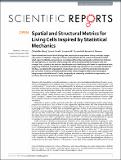Files in this item
Spatial and structural metrics for living cells inspired by statistical mechanics
Item metadata
| dc.contributor.author | Åberg, Christoffer | |
| dc.contributor.author | Varela, Juan A | |
| dc.contributor.author | Fitzpatrick, Laurence W | |
| dc.contributor.author | Dawson, Kenneth A | |
| dc.date.accessioned | 2018-12-11T17:30:08Z | |
| dc.date.available | 2018-12-11T17:30:08Z | |
| dc.date.issued | 2016-10-06 | |
| dc.identifier | 256889408 | |
| dc.identifier | c5c38059-71cb-47df-8828-8b57d26b60a5 | |
| dc.identifier | 27708351 | |
| dc.identifier | 84990847904 | |
| dc.identifier.citation | Åberg , C , Varela , J A , Fitzpatrick , L W & Dawson , K A 2016 , ' Spatial and structural metrics for living cells inspired by statistical mechanics ' , Scientific Reports , vol. 6 , 34457 . https://doi.org/10.1038/srep34457 | en |
| dc.identifier.issn | 2045-2322 | |
| dc.identifier.other | PubMedCentral: PMC5052623 | |
| dc.identifier.other | ORCID: /0000-0003-1901-1378/work/51700178 | |
| dc.identifier.uri | https://hdl.handle.net/10023/16666 | |
| dc.description | Funding from the Irish Research Council for Science, Engineering and Technology (C.Å.); Science Foundation Ireland, 09/RFP/MTR2425 (J.A.V.; C.Å.) and 12/IA/1422 (K.A.D.); the European Union Seventh Framework Programme project NanoTransKinetics, grant agreement no. 266737 (C.Å.) and FutureNanoNeeds grant agreement no. 604602 (K.A.D.); and the Irish Research Council (L.W.F.) is gratefully acknowledged. | en |
| dc.description.abstract | Experimental observations in cell biology have advanced to a stage where theory could play a larger role, much as it has done in the physical sciences. Possibly the lack of a common framework within which experimentalists, computational scientists and theorists could equally contribute has hindered this development, for the worse of both disciplines. Here we demonstrate the usage of tools and concepts from statistical mechanics to describe processes inside living cells based on experimental data, suggesting that future theoretical/computational models may be based on such concepts. To illustrate the ideas, we describe the organisation of subcellular structures within the cell in terms of (density) pair correlation functions, and subsequently use the same concepts to follow nano-sized objects being transported inside the cell. Finally, we quantify an interesting subcellular re-organisation, not previously discerned by molecular biology methods. | |
| dc.format.extent | 8 | |
| dc.format.extent | 675950 | |
| dc.language.iso | eng | |
| dc.relation.ispartof | Scientific Reports | en |
| dc.subject | Cell line | en |
| dc.subject | Humans | en |
| dc.subject | Models | en |
| dc.subject | Biological | en |
| dc.subject | QH301 Biology | en |
| dc.subject | QD Chemistry | en |
| dc.subject | NDAS | en |
| dc.subject.lcc | QH301 | en |
| dc.subject.lcc | QD | en |
| dc.title | Spatial and structural metrics for living cells inspired by statistical mechanics | en |
| dc.type | Journal article | en |
| dc.contributor.institution | University of St Andrews. School of Biology | en |
| dc.identifier.doi | 10.1038/srep34457 | |
| dc.description.status | Peer reviewed | en |
This item appears in the following Collection(s)
Items in the St Andrews Research Repository are protected by copyright, with all rights reserved, unless otherwise indicated.

